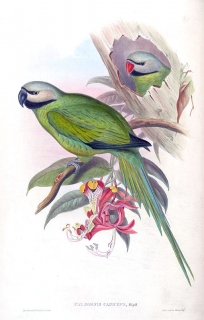Nicobar Parakeet |
|
|
Also known as: Blyth's Parakeet, Blyth's Nicobar Parakeet
Photos
View in GalleryDid You Know?
The Nicobar Parakeet is the largest of the Psittacula parakeets, at 45cm (17.5 in).Academic Research
Related publications: Psittacula canicepsSpecies Profile
Genus: Psittacula | Species: caniceps
Size:
56cm (21.8 in)
Weight:
225g.
Subspecies including nominate:
one
Colour Adult:
Both adults mostly green in colour; mauve/blue tinge to crown and nape in male, more blue in female; black stripe from forehead to area around eyes; black, wide band from chin across lower cheeks; yellow/grey upper cheeks to ear coverts, turning to dull mauve/grey near hindneck; green tail tipped with yellow. Red upper mandible in male, black in female, black lower mandible in both sexes. Eye orange/red.
Colour Juvenile:
Not recorded.
Call:
Calls are described as raucous and crow-like.
More Information:
Content Sources:
CITES
BirdLife International
Cornell Lab of Ornithology/Birds of the World
A Guide to Parrots of the World, Juniper and Parr, 1998
Parrots of the World, Forshaw and Cooper, 1989.
Parrots of the World, Forshaw, 2006.
Lexicon of Parrots, Thomas Arndt.
Photos
View in GalleryDid You Know?
The Nicobar Parakeet is the largest of the Psittacula parakeets, at 45cm (17.5 in).Academic Research
Related publications: Psittacula canicepsSpecies Care
Captive Status:
Not found in captivity.
Longevity:
Not recorded.
Housing:
Not recorded.
Diet:
Not recorded.
Enrichment:
Not recorded.
Nest Box Size:
Not recorded.
Clutch Size:
Possibly 1-2 eggs.
Incubation Time:
Not recorded.
Fledging Age:
Not recorded.
Hatch Weight:
Not recorded.
Peak Weight:
Not recorded.
Weaning Weight:
Not recorded.
Photos
View in GalleryDid You Know?
The Nicobar Parakeet is the largest of the Psittacula parakeets, at 45cm (17.5 in).Academic Research
Related publications: Psittacula canicepsSpecies Wild Status
World Population:
10,000-20,000
IUCN Red List Status:
Near Threatened
CITES Listing:
Appendix II
Threat Summary:
Not globally threatened. A BirdLife “restricted-range” species. Is threatened by trapping and land development. The tsunami in the Indian Ocean in 2004 may have caused a significant decline in numbers. The species may qualify for uplisting in the future should this be supported by empirical evidence.
Range:
Great Nicobar, Little Nicobar, Menshal, and Kondul, in Nicobar Islands, Bay of Bengal.
Habitat:
Found in high rainforest.
Wild Diet:
Feeds on Pandanus fruits; other diet items unknown.
Ecology and Behaviour:
Generally remains sequestered in high canopy, particularly when not feeding. Usually seen in pairs or small groups.
Clutch and Egg Size:
Possibly 1-2 rounded eggs, 38.0 x 25.5mm (1.5 x 1.0 in).
Breeding Season:
Not recorded.
Related Links:
Photos
View in GalleryDid You Know?
The Nicobar Parakeet is the largest of the Psittacula parakeets, at 45cm (17.5 in).Academic Research
Related publications: Psittacula canicepsMembers Only Resources
Please log-in now to find more research, resources and tools.
Not a Member?
Find more great information:
Gain exclusive access to 600+ pages of additional research, seminars and podcasts, specialists to ask your toughest questions, and dozens of other fun resources - when you become a WPT member.
Join Today >>

































